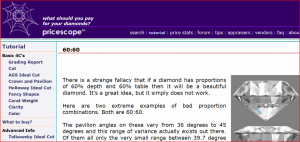I know America is bigger than Britain but remember AGS and GIA have an A in them standing for America. These names are not known over here. GIA is more heard of now but I have never seen AGS mentioned in anything here. IGI is known, maybe they could promote David's Top Proportion new diamond cut. They could educate people and carry out scientific experiments on scintillation and color etc. It is all marketing.
Even Tiffany does not associate its diamonds with GIA now.
GIA Excellent
AGS Ideal
IGI? or maybe David could found a lab Top Proportion or probably just Proportion as they all use only one word notice. It is all in the scheme of things, marketed an promoted. One word only needed!!!
Even Tiffany does not associate its diamonds with GIA now.
GIA Excellent
AGS Ideal
IGI? or maybe David could found a lab Top Proportion or probably just Proportion as they all use only one word notice. It is all in the scheme of things, marketed an promoted. One word only needed!!!





300x240.png)